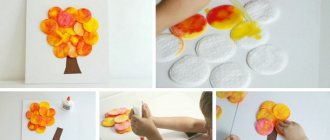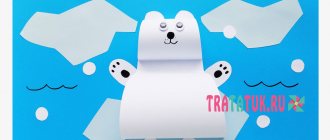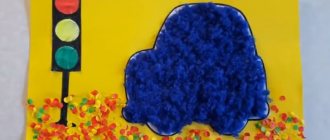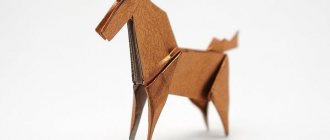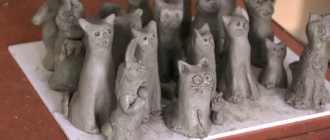Preparatory group. Senior preschool age. Children 6-7 years old
Photo report for the International Thank You Day. Application in the preparatory group “Flower - give a smile”
Goal: To teach children different ways and forms of expressing joy and good mood. Objectives: - Develop a sense of composition, - Teach how to create an image of a smiley face and a flower out of paper, - Strengthen the ability to work with paper, scissors, learn to attach a stick - a stem using...
Children's master class on the application "Winter" for children of senior preschool age
I present to your attention, dear colleagues, a children’s master class on the application “Winter - Winter”
.
This work can be done together with children of older preschool age. Target. To develop the ability to create a composition of a winter landscape using the appliqué . Tasks….
Positive aspects of creating applications
This type of crafts has a very beneficial effect on the development of the child. The main advantages of creating applications:
- Development of fine motor skills of the hands;
- Development of creative and logical thinking;
- Trains perseverance and accuracy;
- While working, the baby remembers what objects look like and what they are called.
Also, in this way, a child can create not just a simple standard craft, but also present the work as a gift or interior decor.
Types of applications made from natural materials
- Overlay applique. A simple look that does not require additional work with leaves - they are glued to a sheet of paper or cardboard, creating the intended plot. These can be animals, trees, mushrooms. You can add some details.
- Mosaic or modular application. This technique involves gluing leaves that are identical or similar in shape. This way you can make a bird's tail or fish scales.
- Symmetrical applique. In this case, it is necessary to select similar leaves to create mirror images. This way you can make an image in water, a butterfly, a dragonfly.
- Ribbon applique. A type of symmetrical applique, but in this case you can make several similar images.
- Silhouette applique. The leaves are trimmed to create the desired pattern or shape.
Children become interested in applications and crafts even at the stage of collecting material. Kids like to collect leaves on the paths while walking, look for cones and chestnuts. Therefore, it will not be difficult to persuade your child to use all this to create a beautiful applique.
Fauna of the Far North
There are many master classes on the Internet about animals living in permafrost conditions. Children know these waterfowl from books and cartoons.
Panda
The clothes of this exotic animal look very unusual. The procedure for making a panda is as follows. A larger cut out black oval will serve as the body, and a smaller one for the abdomen.
Other components are black paws and a red mouth. All components are attached to the base with glue. The cheerful panda is ready!
Applications are not only made of paper, but also partially made of cotton wool. Most often they decorate the body and head of animals. The material is glued in a solid piece or in the form of rolled balls.
If you paint the cotton wool, you will get a delightful craft.
Multi-colored woolen threads, cereals or plasticine are also used for decoration. This activity is very useful for children, as it teaches perseverance and develops creativity!
Applique Autumn bouquet
This craft is quite suitable as a gift for a teacher or mother from a schoolchild. After all, such a bouquet of leaves will last much longer than a fresh bouquet of real flowers.
Pre-dry leaves from different trees. Prepare glue, scissors and a sheet of cardboard.
Form a vase from the leaves by gluing them onto cardboard. And then help your child create a beautiful bouquet of leaves. To make it bright and neat, use light leaves for the craft, without holes or stains.
A vase for an autumn bouquet of leaves can be made from colored paper, or you can create a bouquet not only from leaves and do without a vase.
Fruit basket
Quite an interesting way to create a fruit applique from felt. This material is sold in a wide range of colors and is easy to work with. Also for this craft you will need: a sheet of cardboard, brown paper, scissors, a glue gun and sticks for it, a pencil, a newspaper.
Action plan.
- Draw a basket on a sheet of cardboard.
- Cut the sheets of paper into strips about 2 cm wide and roll them into thin tubes, seal the edges well.
- Lay out the outline of the basket from newspaper tubes, cutting them to the desired size.
- Tear the brown paper into small pieces and roll them into tight balls.
- Glue the balls over the entire area of the basket, so that there is no gap between them.
- Cut out the desired fruits from felt, attach them to the basket in a happy order and glue them.
In principle, for such a volumetric application of fruits and vegetables, you can use seeds and cereals, as well as eggshells.
Applications depicting fruits and berries allow you to create colorful works from a variety of materials and using different techniques. Even the smallest creative hands can begin their acquaintance with appliques with vegetables, berries, fruits, and older children can create entire compositions.
Lesson: applique “Autumn”
The very first creative activity “Autumn Application”
awaits children in the junior group of kindergarten, where they are just getting acquainted with the simplest techniques of working with paper.
First, children need to be prepared for the creative process: while walking with children on the playground, it is necessary to draw their attention not to what changes in nature occur with the arrival of the first autumn months. The kids can talk about what the color of the leaves was in the summer and what it is now. Draw their attention to the fact that every day the leaves fall to the ground and soon the trees will remain completely bare, until, with the arrival of spring, small green leaves begin to appear on them again. The teacher must explain that such changes occur in nature every year, and each season has its own “unusualities”, which are reflected in fairy tales and stories of writers, in children's songs, riddles and paintings.
When you and the children return to the group, before the actual creative activity begins, you need to show them famous paintings that depict the autumn theme, turn on children's songs, and be sure to solve a few simple riddles together with the children.
In the younger group, creative activities should take place in a playful way, because kids don’t like to sit in one place for a long time, they want to be constantly on the move. And only after the educational game can the teacher invite the children to take their place at the table and start making applications on the theme of autumn for kindergarten
.
During the lesson, kids will acquire the first skills of composing a composition, because they will have to independently (and if necessary, with the teacher’s prompts) lay out leaves of different shapes on a paper base, and then carefully glue them. Perhaps this will be the child’s first experience working with glue, so first the teacher should show which side the paper form should be coated with glue, how to apply it to the base and how long to wait for it to stick.
During the lesson, the child will have an idea of what colors represent October - work will be done with yellow, red, orange.
Since the children of the younger group do the most, the teacher must independently prepare all the necessary material for them, make paper blanks, so that during the lesson the child only has to arrange and glue them correctly.
Simple applications for children 2-3 years old
Simple applications made from colored paper using templates can be practiced from the age of 2. However, some experts believe that children as young as 1 year can perform feasible tasks.
Initial lessons involve gluing pieces of paper onto a sheet in any form. At this stage, the child must understand and remember the basic actions: spread, turn over, apply, smooth. Kids are still attracted to the process itself; they will strive for the result later.
At the second level of complexity, templates are used. The child must place the elements also chaotically, but within the contour, and a certain image appears.
Application template from colored paper “Hedgehog”
A template is a schematic image of a future picture, drawn or printed on a printer. Simple templates for applications made from colored paper can include, for example, a Christmas tree with balls, a tree with apples, and others.
For such work, you need to prepare elements: balls, apples, etc. The child must determine for himself how to arrange them on the templates.
Palm tree applique template
Flower applique template
For small children, it will be interesting to perform a simple cut-out appliqué. The child watches the adult tear the paper into long strips, then tears them into shreds himself. These pieces need to fill the outline.
If the child wants to tear the paper himself, then these uneven, awkward strips can also be used to create an applique, for example, grass. Ants are drawn using finger paints.
Further, the task becomes more complicated: you need to hit the element on a specific place in the template or drawn outline. So, using cut out circles, an image of a caterpillar is created. At this stage, children are no longer interested only in the process, but also in the result.
When making appliqués from colored paper using templates and contours with children under 3 years of age, prepared cut out elements are used.
A three-year-old child can already be taught the skills of working with scissors with rounded ends.
At the same time, it is necessary to explain how to properly hold scissors and paper so as not to get hurt. You need to start with straight cuts, then work on bends and roundings.
At this age, children are already able to create simple plot pictures. Elements pasted onto the template allow you to create a specific image.
The background for the application can be a drawn outline with partially drawn elements. For example, children can populate a template aquarium with algae and stones at the bottom with inhabitants: fish, jellyfish, etc.
An interesting activity can be connecting and gluing a cut picture. If a child copes with such a task easily, it is recommended to complicate it: add raindrops to the umbrella, glue windows to the house with an attached roof. Such activities develop imagination, observation, and a sense of proportion.


